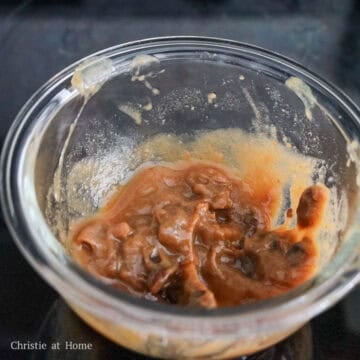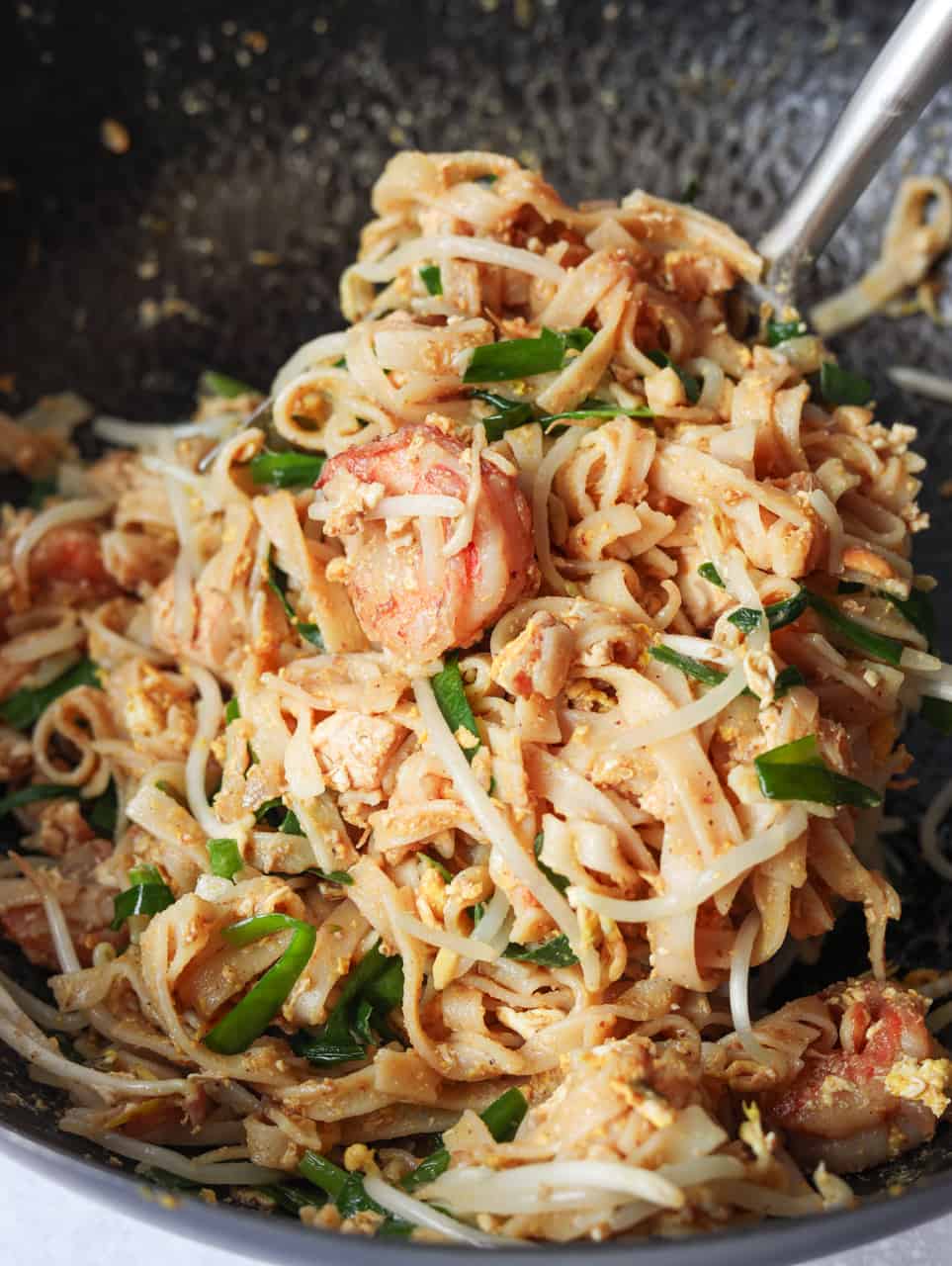Jump to:
What is Shrimp Pad Thai?
Shrimp Pad Thai is a popular Thai dish from Thailand. It's made of flat rice noodles stir fried over high heat in a wok with shrimp, tofu, eggs, garlic chives, bean sprouts, shallots, garlic in a delicious sweet, tangy, savory sauce.
The sauce is made of tamarind, fish sauce, and palm sugar and it balances out the savory taste of the other ingredients. You'll often find this Thai dish served at many Thai restaurants or at food stands as street food.

Shrimp pad thai is one of my favourite noodle dishes ever. I always order it as I love that sweet and savory combination. But now you can easily make this Thai dish at home!
If you're not a fan of shrimp, feel free to check out my Chicken Pad Thai recipe.
Ingredients & Substitutes
Please scroll down to below recipe card for exact measurements.

- Jumbo shrimp: peeled and deveined. I recommend purchasing the easy peel kind that has already been deveined to make the preparation process easier!
- Thin flat rice noodles: avoid using the wider flat rice noodles. The thin ones are about 0.5 millimetre wide and they come dried. You can find this at most Asian grocers.
- Firm tofu or Extra Firm tofu: I wouldn't suggest using medium or soft tofu as these will break easily in the pan.
- Eggs
- Mung bean sprouts: or substitute with soy bean sprouts if you can't find the mung bean version.
- Garlic chives (aka Chinese chives): these are very long wide chives that are not the same as normal chives which are shorter.
- Shallot: shallots are commonly used in Thai cuisine over white onion. I highly recommend shallots if possible as they have a much sharper taste than white onions.
- Garlic
- Water
- Neutral oil: like avocado oil, sunflower oil, grapeseed oil, peanut oil, vegetable oil or canola oil with a high smoke point. Avoid olive oil that has a low smoke point.
- Lime: optional garnish
- Peanuts: optional garnish
Note: Your Asian grocery store will carry most of the Asian specific ingredients.
Pad Thai Sauce

- Palm sugar: or sub with brown sugar
- Fish sauce: a common ingredient used in Southeast Asian cooking made of fish oils and salt that lends a very deep umami flavor!
- Water
Tamarind Concentrate

- Tamarind pulp: this usually comes in brown pulp block with tamarind seeds through out. You'll need to cut off a small piece of it to soak into the hot boiling water to create the tamarind extract or tamarind concentrate. This is the best way to create this concentrate and I highly recommend it over using store bought tamarind concentrate as it doesn't taste the same.
- Hot boiling water
Expert Tips
- Soak tamarind pulp in hot boiling water and wait until the water is cool enough to touch to avoid burning your hands.
- Massage tamarind pulp with hands to squeeze out and remove the seeds. You can also use a fork but you won't be able to extract as much pulp.
- Use a fine sieve to extract the tamarind concentrate. Once your pulp has dissolved with the water, run it through a fine sieve to extract the concentrate and to remove the hard bits and seeds. This can be used for other purposes or composted.
- Do not over soak rice noodles. Just soak until they are limp but firm. It's always best to under soak the noodles versus over soaking them. You can always cook them for longer in the pan so they cook to your desired consistency.
- Use a non-stick pan or a well-seasoned wok so the noodles don't stick!
- Do not fully cook the shrimp or they will dry out in the stir frying process later.
- Be gentle when frying the tofu or it can break apart.
- Taste test the noodles as you stir-fry them. They will need a few splashes of water to cook them in the pan.
- Don't overcook the veggies. Once they've been tossed with the other ingredients, remove off heat.
Instructions
Below are step-by-step instructions on how to make shrimp pad thai:

To make your tamarind concentrate: submerge tamarind pulp in ⅓ cup hot boiling water. Allow for it to cool and then with your hands, squeeze and massage the pulp as best you can, until it dissolves in the water.

Strain as much as the tamarind liquid through a fine sieve and discard the hard bits and seeds, reserving the liquid which is now your tamarind concentrate.

Combine tamarind concentrate, fish sauce, palm sugar and water until sugar has dissolved. Set aside.

Soak your rice noodles in hot boiling water for 2 minutes until limp but firm and strain. Set aside. Do not over soak the noodles!

In a large pan medium high heat, add 1 tablespoon oil and the shrimp. Fry until 50% cooked. Remove and set aside.

If needed, add another 1 tablespoon of oil. Fry shallots and garlic for 10 seconds. Add firm tofu and gently toss for 20-30 seconds.

Toss in rice noodles and sauce mixing for 2-3 minutes. Taste your noodles to see if they're chewy at this point, if not add a 2-3 tablespoons of water to help cook them until they are.

Add shrimp, then push everything to the side. Add remaining oil into the empty space of wok followed by eggs. Scramble them first and then mix in with noodles.

Toss in bean sprouts and garlic chives for 10-20 seconds. Remove off heat. Do not overcook them as they will wilt with the residual heat anyway. Optional: serve with limes and crushed peanuts. Enjoy!
Storage
- Pad thai is best consumed fresh as the noodles will become soggy over time.
- Leftovers will last up to 4 days stored in an airtight container in the refrigerator. To reheat: microwave for 2-3 minutes until hot or reheat in a pan on medium heat.
- Freezer friendly? I don't recommend freezing shrimp pad thai as the noodles will become soggy.
Pairing Suggestions
Shrimp pad thai serves well with:
- starters like egg rolls
- cooked vegetables like bok choy, spicy garlic bok choy, choy sum, gai lan, garlic green beans or stir fried snow pea leaves.
- cooked protein like bang bang shrimp, crying tiger beef, Thai garlic shrimp, or pad kra pao
- noodle dishes like Thai Drunken Noodles, or Pad See Ew,
FAQ
There are a few reasons for this and they include over soaking or even boiling the noodles when you should only blanch them for 1-2 minutes until firm but limp, overcooking them in the pan, or using too much heat.
I don't recommend it. In my experience, tamarind concentrate doesn't taste like the real thing made of tamarind pulp and hot boiling water.
Other recipes you may like
📖 Recipe

Quick & Easy Shrimp Pad Thai
Ingredients
- 10 jumbo shrimp deveined and your preference to leave it peeled or unpeeled
- 4.05 oz dried thin flat rice noodles
- 4.05 oz firm tofu cubed
- 2 large eggs
- 1 ¼ cup bean sprouts
- 1 cup garlic chives chopped into 1 inch length
- ½ shallot chopped
- 1 clove garlic roughly minced
- 3 tablespoon vegetable oil or any neutral oil
Sauce:
- 3 tablespoon palm sugar finely chopped or sub with brown sugar
- 1.5 tablespoon fish sauce
- 3 tablespoon water
Tamarind Concentrate for Sauce
- 2.11 oz tamarind pulp
- ⅓ cup hot boiling water
Optional
- ½ lime garnish
- ¼ cup peanuts crushed, for garnish
- 2-3 tablespoon water if needed to help cook noodles
Instructions
- To make your tamarind concentrate: submerge tamarind pulp in ⅓ cup hot boiling water. Allow for it to cool and then with your hands, squeeze and massage the pulp as best you can, until it dissolves in the water.
- Strain as much as the tamarind liquid through a fine sieve and discard the hard bits and seeds, reserving the liquid which is now your tamarind concentrate.
- Combine tamarind concentrate, fish sauce, palm sugar and water until sugar has dissolved. Set aside.
- Soak your rice noodles in hot boiling water for 2 minutes until limp but firm and strain. Set aside. Do not over soak the noodles!
- In a large pan medium high heat, add 1 tablespoon oil and the shrimp. Fry until 50% cooked. Remove and set aside.
- If needed, add another 1 tablespoon of oil. Fry shallots and garlic for 10 seconds. Add firm tofu and gently toss for 20-30 seconds.
- Toss in rice noodles and sauce mixing for 2-3 minutes. Taste your noodles to see if they're chewy at this point, if not add a 2-3 tablespoons of water to help cook them until they are.
- Add shrimp, then push everything to the side. Add remaining oil into the empty space of wok followed by eggs. Scramble them first and then mix in with noodles.
- Toss in bean sprouts and garlic chives for 10-20 seconds. Remove off heat. Do not overcook them as they will wilt with the residual heat anyway. Optional: serve with limes and crushed peanuts. Enjoy!







Leticia
I want to try this recipe, but, in the description, I don’t see when you put whisked eggs 😕
christieathome
Thanks so much for letting me know! I've added in the instructions for the eggs.
Rosemary
Okay, I'm sorry to say that the last time I tried pad thai was back in like 2012 in NYC LOL!! I have to get them again soon hehe!
Leanne
I’ve never made pad Thai at home. I appreciate that you’ve made this recipe easy to follow! I’ll have to try it some time!